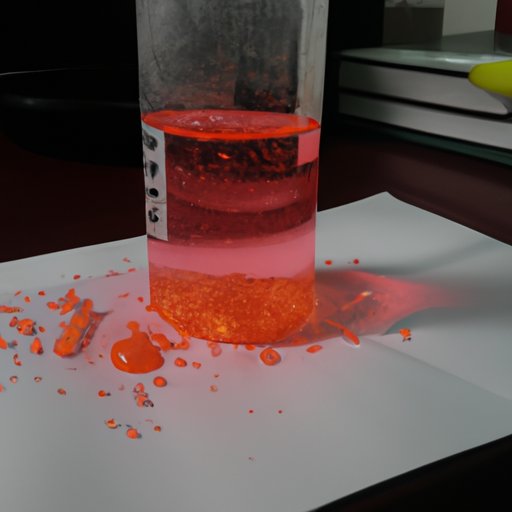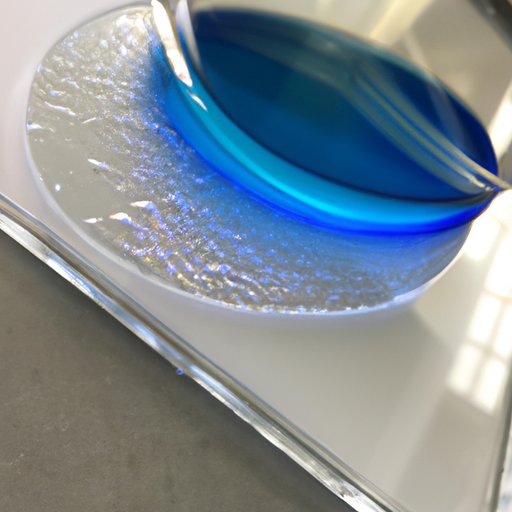Introduction
Colloids are a type of matter that are made up of small particles suspended in a medium. Colloids are found everywhere in nature, from clouds to the human body. In science, colloids are studied for their unique properties and characteristics, which can be utilized in various applications. This article will explore what colloids are in science, how they are used in everyday life, and the properties and characteristics of colloids.

Exploring the Basics of Colloids in Science
A colloid is a homogenous mixture of two or more substances, one of which is dispersed throughout the other. The dispersed substance, known as the colloidal particles, are usually smaller than one micrometre in diameter. The other substance is known as the dispersion medium, and can either be a solid, liquid or gas. Colloids are different from solutions, which are mixtures of two substances where one is dissolved in the other.
Colloidal particles can be divided into two main categories: solids and liquids. Solid colloids contain tiny particles of solid material suspended in a liquid or gas. Examples of solid colloids include fog, smoke, and dust. Liquid colloids contain tiny droplets of liquid suspended in a gas or solid. Examples of liquid colloids include whipped cream, mayonnaise, and milk.
Colloids have several unique properties and characteristics, such as surface tension, size, and distribution of particles. Surface tension refers to the tendency of a liquid to resist being pulled apart, due to the attraction between molecules on the surface of the liquid. The size and distribution of particles refer to the size of the particles and how they are distributed in the dispersion medium. For example, in a solution, particles are evenly distributed throughout the medium, while in a colloid, particles are unevenly distributed.

How Colloids Impact Our Everyday Lives
Colloids are found in many everyday products and materials. For example, paint, ink, and food additives are all colloids. Colloids are also found in nature, such as in clouds, fog, and sea foam.
Colloids play an important role in nature. They can help stabilize soil structure, reduce erosion, and provide nutrients to plants. Additionally, colloids can help filter out pollutants from water, air, and soil.
Examining the Properties and Characteristics of Colloids
The properties and characteristics of colloids are determined by the size and distribution of colloidal particles in the dispersion medium. These particles are suspended in the medium, meaning that they are not dissolved, but rather remain separate from each other. This suspension is what gives colloids their unique properties.
Surface tension is one of the most important properties of colloids. It is caused by the attraction between particles on the surface of the liquid. This attraction creates a “skin” on the surface of the liquid, which can be seen when a drop of liquid is placed on a flat surface. The higher the surface tension, the stronger this “skin” is.
The size and distribution of particles in a colloid also affects its properties. Smaller particles are more evenly distributed throughout the medium, while larger particles tend to settle at the bottom. This can affect the physical properties of the colloid, such as its viscosity and color.

Applications of Colloid Science in Industry
Colloids have many industrial applications. They can be used to create products such as paints, inks, and adhesives. They can also be used to create emulsions, suspensions, and foams. Additionally, colloids can be used in filtration processes, such as water purification.
The use of colloids in industry has many benefits. Colloids can improve product quality and performance, reduce production costs, and increase efficiency. Additionally, colloids can be used to create products with specific properties, such as increased viscosity or improved stability.
Investigating How Colloids are Used in Medicine
Colloids are also used in medicine. They can be used to deliver drugs to specific parts of the body, or to treat medical conditions such as cancer. Colloids can also be used to create medical devices, such as dialysis machines and artificial organs. Additionally, colloids can be used to diagnose diseases, such as HIV and malaria.
The use of colloids in medicine offers many advantages. Colloids can improve drug delivery, increase the effectiveness of treatments, and reduce side effects. Additionally, they can be used to create biocompatible materials, which can be safely implanted in the body.
Conclusion
In conclusion, colloids are a type of matter that are made up of small particles suspended in a medium. They have many unique properties and characteristics, which can be utilized in various applications. Colloids are found in many everyday products, as well as in nature. They are also used in industry and medicine, offering numerous benefits. Understanding the basics of colloids can help us better appreciate their importance in our lives.
This article has explored what colloids are in science, how they are used in everyday life, and the properties and characteristics of colloids. We have also examined the industrial and medical applications of colloids, and the advantages they offer. Hopefully, this article has provided you with a better understanding of colloids and their importance in our world.
(Note: Is this article not meeting your expectations? Do you have knowledge or insights to share? Unlock new opportunities and expand your reach by joining our authors team. Click Registration to join us and share your expertise with our readers.)
